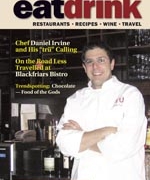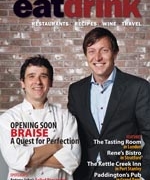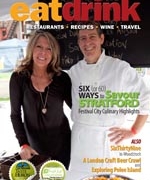Waiter Secrets
What are the secrets to being a great waiter? Phoebe Damrosch learned there’s more to it than writing “Thank you” in bubble letters next to a smiley face on the cheque at the end of a meal. By working her way into the restaurant of a celebrity chef and learning from the best in the field, she became privy to those secrets. Service Included: Four-Star Secrets of an Eavesdropping Waiter chronicles her success moving from English student busboy to dining room captain.
With a fear of office work and her English degree not being fully utilized, Phoebe found herself in the cliché position of starving artist working in a cafe that “employed artists as if there were quotas to be met.” Accepting that restaurants may be in her future for some time, she leapt into the frenetic world of fine-dining. The setting is Per Se restaurant in New York; the boss is Thomas Keller, renowned chef of French Laundry fame. Damrosch’s mission to land a job at the prestigious restaurant was successful and she began learning the ropes by watching experienced waiters, maitre d’s, chefs, and sommeliers around her. She received an overload of training in service etiquette and food knowledge, such as marking the table with silverware for the appropriate number of courses and knowing the difference when Provencal or Tuscan olive oil was used by a chef. Damrosch was at Per Se from its inception and, as New York’s first female captain, became an integral part of the restaurant’s success, including the continuous appeasement of restaurant critics to garnish four-star ratings and receive favourable reviews in the New York Times.
Even while her own food obsession led to failed experiments in a tiny apartment kitchen with the exquisite (yet perhaps unattainable) recipes from The French Laundry Cookbook, she realized that her strengths lie in putting guests at ease with their dining experience. And with this realization comes her best advice to waiters when she writes, “The secret to service is not servitude, but anticipating desire … This was about the art of careful observation and the intimacy of knowing what someone wants before he does.”
Although the foodie aspects of being a waiter are centre stage, there are personal diversions of love affairs with co-workers and family weddings that make the book feel novel-like at times. But it is the tips and anecdotes, both humorous and true, from the field of restaurant service that give the book its enjoyable flavour, such as this morsel of sarcastic advice to diners: “If you want to change the majority of the components of a dish, you might consider choosing something else.” Or equally as cheeky: “Please do not send something back after eating most of it.” It’s convenient that “writer” is only one letter different than “waiter” but it’s no accident that this first-time author has melded the two careers together for a revealing and entertaining look at the service side of restaurant culture.









